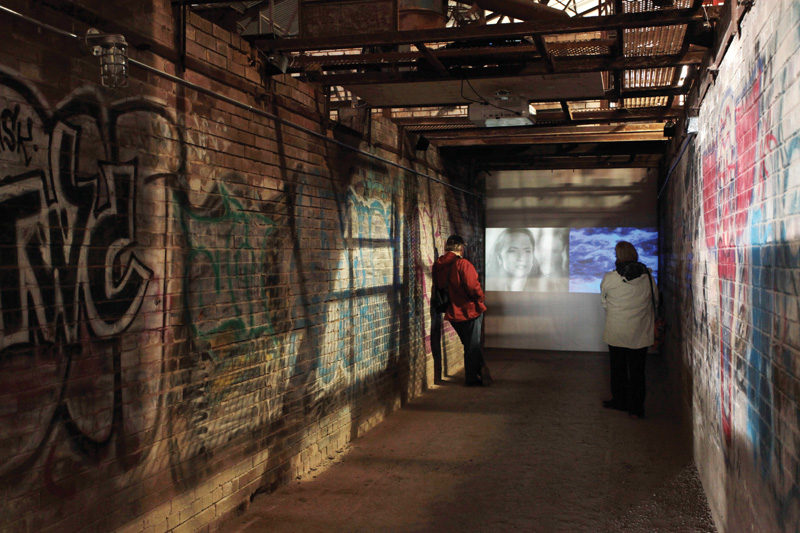[Spring/Summer 2011]
Four Directions
No.9, Public Film and Video Exhibition, Toronto
September 26 to December 31, 2010
“Four Directions: A No. 9 Public Film and Video Exhibition” juxtaposes Werner Herzog’s film Lessons of Darkness (1992), a documentation of the oil fields burning at the conclusion of the Persian Gulf War, with video works by Isabelle Hayeur, Val Klassen, and Dana Claxton. These artists’ works respond to themes addressed in Herzog’s film and reflect upon the mandate of the arts organization, No. 9 Contemporary Art and Environment, as well as the site-specific possibilities of the Evergreen Brickworks, a post-industrial complex of buildings reclaimed from what had been the Don Valley Brick Works. As these works are site-specific installations, their meaning cannot be disassociated from the local setting in which they are encountered.
The Evergreen Brickworks charges the exhibition with a powerful mix of industrial actuality, community activity, and environmental education. It is therefore fitting that the exhibition leads off with Herzog’s bleakly beautiful take on environmental education. The exhibition’s opening stanza is the symphonic representation of epic destruction and warning in Herzog’s Lessons of Darkness. It is installed in the first of four large industrial kilns and exposed to the elements, and I found myself shivering in the cold darkened space while the hell fires of Kuwait, as captured by Herzog, burned on screen. Herzog is well known for fudging the historical record (for example, there is no mention of Kuwait in this post–Gulf War film) and for the grandiose and allegorical themes that he addresses in his documentary films. If Herzog’s film is the master narrative to which the other works respond, then the basis of that response is not only a concern with environmental threat and ruin but also allegory as a methodology for responding to history and issues of environmental stewardship.
The No. 9 exhibition initiates a sequence that begins with Herzog’s film and proceeds to Hayeur’s video, L’or Blanc/White Gold, which incorporates the architectural remnants of the brick kiln directly into the screen to create a powerful illusion that blends the actuality of place with recorded image and sound. The video depicts salt, one of the commodities referenced by the title White Gold, falling miraculously into the image of the kiln itself, accompanied by the sound of salt being poured into containers. An open door or window at the far end of the kiln leads the viewer out to a Pacific beach. In this context, the ocean is not only a sign of nature but also a site of shipping, commerce, and the “flow” of goods such as salt or sugar, extracted from one location and sold in another. Allegorically, the work collapses the dichotomy that holds nature and culture apart and references not only the traffic in white gold but the transformation of natural resources into product, a transformation not far removed from the production of bricks from the clay bed beneath Toronto.
Val Klassen’s installation, Cyanide Flats: 50° 54’ 15″ N. / 95° 20’ 20″ W, in the next kiln, depicts two figures, one male and one female, running in a looped repetition across a barren landscape. The Cyanide Flats, near Long Lake, Manitoba is a location where the extraction of cyanide, used in the refining of gold and silver, has created an environmental ruin. The sounds of birds can be heard on the audio track, but this slim note of hope is held in check by the evidence of a dead zone and the repeated image of the running couple, struggling to make ground but really going nowhere. Is the couple running to or from the environmental catastrophe, and does the video loop itself create an allegory of impossible completion for a contaminated zone that we just can’t get beyond? The final work in the exhibition is Dana Claxton’s video montage Water Speaks. This is a dual-channel video piece that mixes images and sounds of water with environmental lessons gleaned from the natural and supernatural worlds. Influenced by her own Indigenous history, Claxton’s video creates a layered representation of the natural environment that addresses the sacredness of water. Spoken in fragments between a woman and the man represented in the work, Claxton’s piece conducts an act of environmental testimony. Considered within the sequence of site-specific installations, this final work brings viewers from lessons of darkness and war to teachings of water and life. The artists and the curator of this challenging installation are to be recognized for instigating this journey across history, environment, and time, and for enlivening the industrial heritage of a localized site with an environmental pedagogy of the elements.
Blake Fitzpatrick is a professor and the graduate program director of the Documentary Media Program (MFA), School of Image Arts, Ryerson University. He is an active photographer, curator, and writer. His research interests include photographic responses to the nuclear era, imaging the remains of the Berlin Wall, and visual responses to contemporary militarism.


